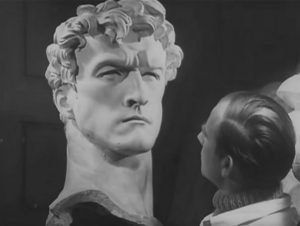Biography from German Art Gallery
Arno Breker (1900 – 1991) was a German sculptor, best known for his public works in Nazi Germany, which were endorsed by the authorities as the antithesis of degenerate art. During his time in Paris in the twenties and early thirties he was influenced by Jean Cocteau, Jean Renoir, Pablo Picasso and Aristide Maillol, who was later to describe Breker as ‘Germany’s Michelangelo’. He maintained personal relationships with Albert Speer and with Hitler. In 1937 Breker joined the National Socialist German Workers’ Party and was made ‘official state sculptor’ by Hitler. He was given a large property and provided a studio with forty-three assistants. As main sculptor and more or less number one on the Gottbegnadeten list, he was exempted from military service. His twin sculptures The Party and The Army held a prominent position at the entrance to Albert Speer’s new Reich Chancellery.
 Arno Breker was represented at the Great German Art Exhibitions with 42 works. The neoclassical nature of his work, with titles like Comradeship, Torchbearer and Sacrifice, typified Nazi ideals, and suited the characteristics of Nazi architecture. On closer inspection, though, the proportions of his figures, the highly colorful treatment of his surfaces (the strong contrasts between dark and light accents), and the melodramatic tension of their musculatures perhaps invites comparison with the Italian Mannerist sculptors of the 16th century. While nearly all of his sculptures survived World War II, more than 90% of his public work was destroyed by the Allies after the war. Arno Breker had 10 sculptures displayed at the XXI Venice Biennale, 1938 and the XXII Venice Biennale, 1940, including ‘Pronti’ (‘Bereitschaft’, GDK 1939), ‘Ricardo Wagner’ (‘Bust of Richard Wagner’, GDK 1941), and ‘Ponderazione’ (‘Berufung’, GDK 1941). Four works by Breker were part of the art collection of Hermann Göring and destinated for the ‘Norddeutsche Gallery’. In 1946 Breker was offered a commission by Joseph Stalin but he refused and stated ‘One dictatorship is sufficient for me’.
Arno Breker was represented at the Great German Art Exhibitions with 42 works. The neoclassical nature of his work, with titles like Comradeship, Torchbearer and Sacrifice, typified Nazi ideals, and suited the characteristics of Nazi architecture. On closer inspection, though, the proportions of his figures, the highly colorful treatment of his surfaces (the strong contrasts between dark and light accents), and the melodramatic tension of their musculatures perhaps invites comparison with the Italian Mannerist sculptors of the 16th century. While nearly all of his sculptures survived World War II, more than 90% of his public work was destroyed by the Allies after the war. Arno Breker had 10 sculptures displayed at the XXI Venice Biennale, 1938 and the XXII Venice Biennale, 1940, including ‘Pronti’ (‘Bereitschaft’, GDK 1939), ‘Ricardo Wagner’ (‘Bust of Richard Wagner’, GDK 1941), and ‘Ponderazione’ (‘Berufung’, GDK 1941). Four works by Breker were part of the art collection of Hermann Göring and destinated for the ‘Norddeutsche Gallery’. In 1946 Breker was offered a commission by Joseph Stalin but he refused and stated ‘One dictatorship is sufficient for me’.
After the war he continued to receive commissions for sculptures, producing a number of works in his familiar classical style, working for businesses and individual patrons. He also produced many bronze female sculptures, in smaller sizes. Some of these were casts from original models designed before 1945.
Today, humanity is only occupied with various materials. Someone takes a piece of railroad track and sets it on a lawn, and that’s supposed to be art.” – Arno Breker
If you look at history, you’ll see there are no schizophrenic sculptors. … We sculptors are too close to the material. We have to deal with stone, with the material. The overcoming of the material is a monumental task, one that challenges me from the moment my day begins.” – Arno Breker
Source Article from http://www.renegadetribune.com/arno-breker-michelangelo-third-reich/
 RSS Feed
RSS Feed















 September 28th, 2017
September 28th, 2017  Awake Goy
Awake Goy 
 Posted in
Posted in  Tags:
Tags: 













